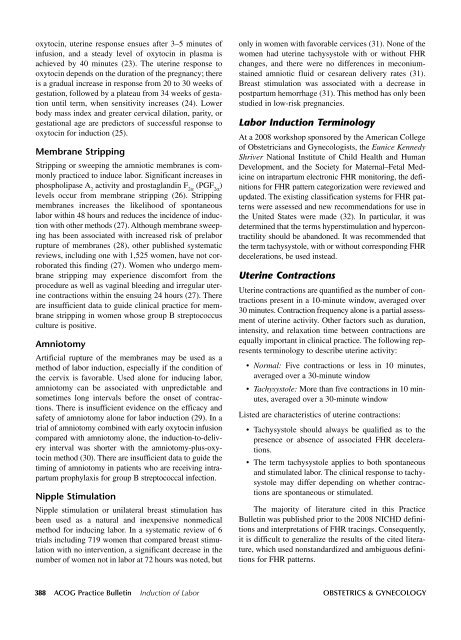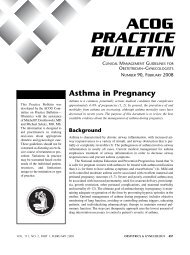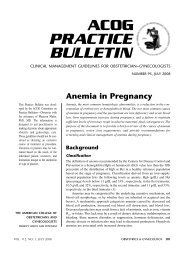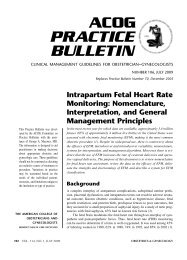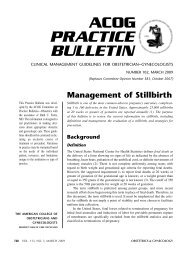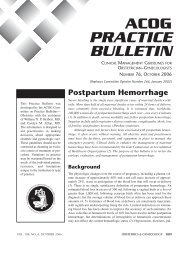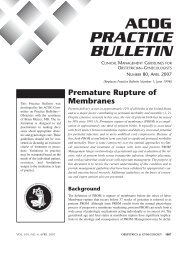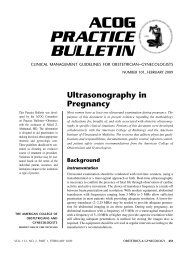ACOG Practice Bulletin
ACOG Practice Bulletin
ACOG Practice Bulletin
Create successful ePaper yourself
Turn your PDF publications into a flip-book with our unique Google optimized e-Paper software.
oxytocin, uterine response ensues after 3–5 minutes of<br />
infusion, and a steady level of oxytocin in plasma is<br />
achieved by 40 minutes (23). The uterine response to<br />
oxytocin depends on the duration of the pregnancy; there<br />
is a gradual increase in response from 20 to 30 weeks of<br />
gestation, followed by a plateau from 34 weeks of gestation<br />
until term, when sensitivity increases (24). Lower<br />
body mass index and greater cervical dilation, parity, or<br />
gestational age are predictors of successful response to<br />
oxytocin for induction (25).<br />
Membrane Stripping<br />
Stripping or sweeping the amniotic membranes is commonly<br />
practiced to induce labor. Significant increases in<br />
phospholipase A 2<br />
activity and prostaglandin F 2α<br />
(PGF 2α<br />
)<br />
levels occur from membrane stripping (26). Stripping<br />
membranes increases the likelihood of spontaneous<br />
labor within 48 hours and reduces the incidence of induction<br />
with other methods (27). Although membrane sweeping<br />
has been associated with increased risk of prelabor<br />
rupture of membranes (28), other published systematic<br />
reviews, including one with 1,525 women, have not corroborated<br />
this finding (27). Women who undergo membrane<br />
stripping may experience discomfort from the<br />
procedure as well as vaginal bleeding and irregular uterine<br />
contractions within the ensuing 24 hours (27). There<br />
are insufficient data to guide clinical practice for membrane<br />
stripping in women whose group B streptococcus<br />
culture is positive.<br />
Amniotomy<br />
Artificial rupture of the membranes may be used as a<br />
method of labor induction, especially if the condition of<br />
the cervix is favorable. Used alone for inducing labor,<br />
amniotomy can be associated with unpredictable and<br />
sometimes long intervals before the onset of contractions.<br />
There is insufficient evidence on the efficacy and<br />
safety of amniotomy alone for labor induction (29). In a<br />
trial of amniotomy combined with early oxytocin infusion<br />
compared with amniotomy alone, the induction-to-delivery<br />
interval was shorter with the amniotomy-plus-oxytocin<br />
method (30). There are insufficient data to guide the<br />
timing of amniotomy in patients who are receiving intrapartum<br />
prophylaxis for group B streptococcal infection.<br />
Nipple Stimulation<br />
Nipple stimulation or unilateral breast stimulation has<br />
been used as a natural and inexpensive nonmedical<br />
method for inducing labor. In a systematic review of 6<br />
trials including 719 women that compared breast stimulation<br />
with no intervention, a significant decrease in the<br />
number of women not in labor at 72 hours was noted, but<br />
only in women with favorable cervices (31). None of the<br />
women had uterine tachysystole with or without FHR<br />
changes, and there were no differences in meconiumstained<br />
amniotic fluid or cesarean delivery rates (31).<br />
Breast stimulation was associated with a decrease in<br />
postpartum hemorrhage (31). This method has only been<br />
studied in low-risk pregnancies.<br />
Labor Induction Terminology<br />
At a 2008 workshop sponsored by the American College<br />
of Obstetricians and Gynecologists, the Eunice Kennedy<br />
Shriver National Institute of Child Health and Human<br />
Development, and the Society for Maternal–Fetal Medicine<br />
on intrapartum electronic FHR monitoring, the definitions<br />
for FHR pattern categorization were reviewed and<br />
updated. The existing classification systems for FHR patterns<br />
were assessed and new recommendations for use in<br />
the United States were made (32). In particular, it was<br />
determined that the terms hyperstimulation and hypercontractility<br />
should be abandoned. It was recommended that<br />
the term tachysystole, with or without corresponding FHR<br />
decelerations, be used instead.<br />
Uterine Contractions<br />
Uterine contractions are quantified as the number of contractions<br />
present in a 10-minute window, averaged over<br />
30 minutes. Contraction frequency alone is a partial assessment<br />
of uterine activity. Other factors such as duration,<br />
intensity, and relaxation time between contractions are<br />
equally important in clinical practice. The following represents<br />
terminology to describe uterine activity:<br />
• Normal: Five contractions or less in 10 minutes,<br />
averaged over a 30-minute window<br />
• Tachysystole: More than five contractions in 10 minutes,<br />
averaged over a 30-minute window<br />
Listed are characteristics of uterine contractions:<br />
• Tachysystole should always be qualified as to the<br />
presence or absence of associated FHR decelerations.<br />
• The term tachysystole applies to both spontaneous<br />
and stimulated labor. The clinical response to tachysystole<br />
may differ depending on whether contractions<br />
are spontaneous or stimulated.<br />
The majority of literature cited in this <strong>Practice</strong><br />
<strong>Bulletin</strong> was published prior to the 2008 NICHD definitions<br />
and interpretations of FHR tracings. Consequently,<br />
it is difficult to generalize the results of the cited literature,<br />
which used nonstandardized and ambiguous definitions<br />
for FHR patterns.<br />
388 <strong>ACOG</strong> <strong>Practice</strong> <strong>Bulletin</strong> Induction of Labor OBSTETRICS & GYNECOLOGY


